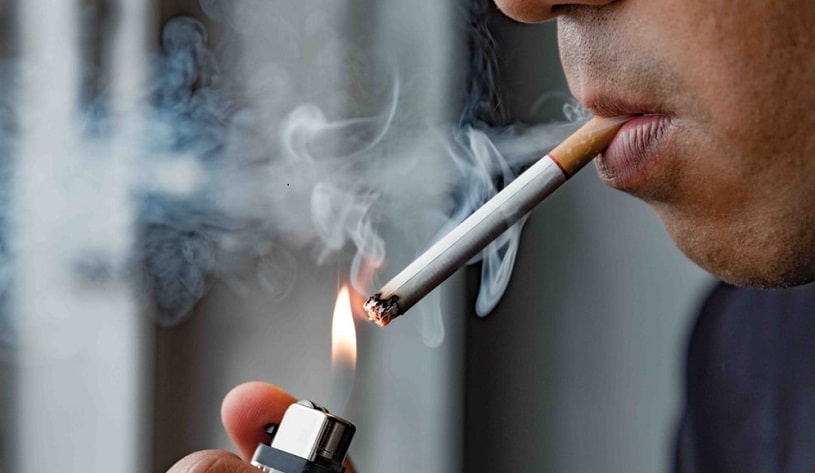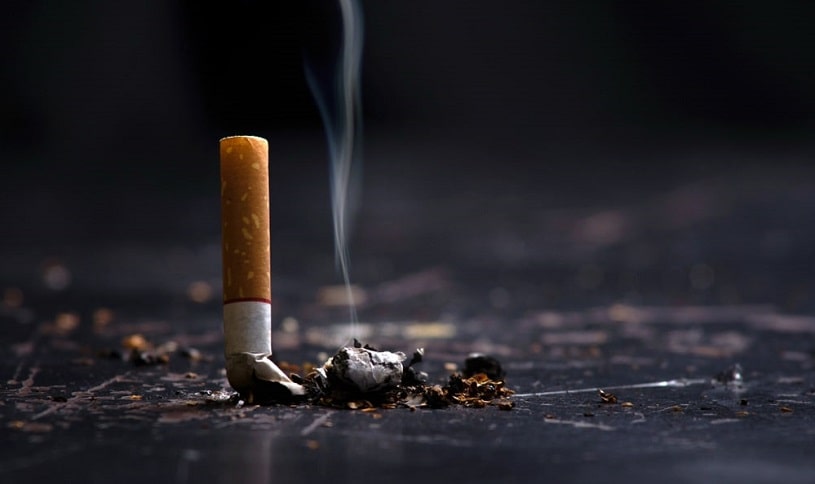Nicotine is the substance found in many tobacco-based products. It is mainly responsible for the “high” tobacco users feel after use. It triggers the release of certain hormones: dopamine, the happiness hormone, serotonin, and endorphins, among others. This effect is largely responsible for repeated use. Over time, this repeated use leads to addiction which causes adverse effects on human health. So, what is nicotine and what treatment options are available to battle nicotine addiction?
Table Of Contents:
What Is Nicotine?
Nicotine is the main active ingredient present in tobacco products like cigars, cigarettes, pipe and chewing tobacco, dried leaves from tobacco plants, and wet and dry snuff. It is also present in electronic cigarettes and plants like tomatoes and potatoes, among other Solanaceae plant family members. Although smoking e-cigarettes is falsely considered safe by some people, there are still some dangers of vaping associated with it.
For recreational uses, it is used for its stimulating and anxiolytic, that is, anxiety-reducing, effects. These effects encourage smoking. Although legal, it still poses a danger to health, especially when abused.
Is Nicotine Addictive?
Yes, it is. From nicotine definition, it can be seen that the substance is present in a wide range of products and is used for different things. Taking the drug for lengthy periods can increase the risk of dependence and addiction. The pleasurable sensation, dopamine release, the adrenaline rush, and the anxiolytic effects of its usage enhance its addiction.

More About Stimulants:
It easily enters the bloodstream once smoked, chewed, or absorbed through the skin. Within 10 seconds, it can reach the brain and interfere with the production of certain chemicals that affect the emotions, mood, energy, overall performance of the body, and health.
Among more than 7000 chemicals that enter the body when smoking cigarettes, nicotine in cigarettes is the most addictive substance that causes the brain to release more epinephrine, which handles the increase in blood pressure, heart rate, and breathing. It is essential to know how long it stays in your system.
It also affects the brain’s reward system by increasing dopamine and serotonin production while suppressing the release of these chemicals without their presence. The effects are short-lived, thus urging the smoker to light another cigarette after a few minutes or hours once the levels drop.
When the levels of these chemicals are boosted, the smoker feels energized, light, and motivated. However, once they decrease, the mood alters negatively, and the person becomes cranky and easily irritated. This makes quitting all the more difficult since addicts have nicotine dependence every time a stressful event occurs or each time they finish their meal. Some people can smoke more than 5 cigarettes in a row, and it’s important to know what amount can cause an overdose.
Risk Groups
Anyone who smokes lives with someone who smokes or is exposed to smoking at a very young age is prone to nicotine addiction. This is because it is a very addictive substance that interferes with different brain chemicals.
In the US, more people are addicted to it than any other addictive drug.
There are many risk factors for developing nicotine dependence, including environmental influences from family and friends, genetics and prenatal consumption (through the smoking mother), age, the use of other substances, and various mental illnesses. From these risk factors, it is easy to determine which group of people is most likely to get addicted.
Smoking Adolescents
Adolescents made up almost 90% of the total new smokers in 2020. Most of them below the age of 18, these first-time cigarette smokers are more likely to die prematurely than non-smokers.

Apart from peer pressure, psychological dilemmas during puberty, and curiosity, studies show that adolescent rats were more vulnerable to addiction. Due to their receptiveness to nicotine in cigarettes, adolescents are more at risk of being addicted than other age groups. Even some teenagers who smoke irregularly may develop an addiction at some point.
Children who See Their Parents Smoke
As early as conception and fetal development, an individual’s nicotine addiction risk factor may start due to a smoking pregnant mother. According to research that was published in Biological Psychiatry, prenatal exposure and high levels of stress hormones increase the fetus’s risk of nicotine dependence during later years. This is particularly applicable to female babies.
Another study published in the journal Pediatrics says that children who have smoking parents are more prone to smoking later on. The longer the parents smoked, the higher the probability became for the children to become addicts.
Our analysis showed that the longer adolescents are exposed to a parent’s smoking when the parent is addicted, the more likely they are to begin smoking and to become regular smokers in the futureThe author of the research, Darren Mays
Adults
Depression, anxiety, and other forms of mental health issues also mean higher risks of developing an addiction. This does not only apply to adults but adolescents as well. According to research, teenagers who suffer from mental depression are 13 times more likely to smoke and begin their substance abuse journey.
In 2010, the direct relation between smoking and depression among adults was confirmed through a study led by the Centers for Disease Controls and Prevention. The researchers said that people above 20 years old with depression had double the risk of being cigarette smokers. The more serious the depression becomes, the more they are likely to smoke.

People find it harder to quit using tobacco than other substances because cigarettes and smokeless tobacco are legal, easy to buy, and widely advertised. In contrast, illegal substances are more difficult to acquire and carry even more negative stigmas and legal consequences.
Nicotine Facts and Statistics
According To a Study Published In The New England Journal of Medicine In 2010:
- Smoking accounted for 435,000 deaths, that is 1 in 5 deaths, in the United States.
- 70% of smokers say they would like to quit, but only 3% of smokers quit successfully.
- There is a 50% chance that a lifelong smoker will die prematurely from a smoking complication.
According to a report by the Centers for Disease Control and Prevention, smokers die about 10 years earlier than non-smokers. Also, 5.6 million Americans younger than 18 years of age are expected to die prematurely from a smoking-related illness if the current smoking rate continues. This figure represents about 1 in every living 13 Americans aged 17 years at most. Also, cigarette smoking is the leading cause of lung cancer. Other tobacco products also increase this risk.
Finally, in research conducted in 2020, about 3 of every 100 middle school students and about 8 of every 100 high school students interviewed reported using two or more tobacco products in the 30 days leading up to the study. These values (4.47 million) showed a 1.73 million youth decline from the values obtained in 2019 (6.20 million).
Nicotine Addiction Symptoms
This alarming statistic proves that nicotine, especially when tobacco-delivered as understood from nicotine definition, is highly addictive (and it doesn’t matter if it comes in the forms of a traditional cigarette or electronic cigarette). It causes physiological and mental dependence accompanied by changes in the emotions and attitude of a person involved. Anyone who is addicted will have a hard time quitting due to extreme cravings and withdrawal symptoms.

Like any other type of drug abuse, nicotine addiction is a complicated matter that has been the subject of countless scientific studies through the years. There is no single way to determine whether a person is addicted. There are, however, nicotine addiction symptoms to look out for to know and subsequently receive proper medical attention at the soonest possible time.
Behavioral Signs
Addiction to any substance brings changes to a person’s behavioral patterns. Gradually but steadily, they alter their behavior and lifestyle so that there is a place for the substance of abuse in their daily schedule.
If an individual lights a cigarette first thing in the morning, if they think that alcohol goes perfectly with tobacco or tobacco-based products, or if they feel the need to smoke while waiting for the bus or after sex, then they are exhibiting nicotine addiction symptoms and it is time to admit that such person has an addiction.
Other Behavioral Signs Include:
- Failing to quit despite multiple attempts
- Experiencing withdrawal symptoms
- Smoking or chewing tobacco in excess
- Consuming tobacco when feeling stressed or bored
- Avoiding smoke-free places or social occasions that don’t involve smoking
- Continued smoking or tobacco use despite an illness that may have been caused or worsened by the habit
- Withdrawal from activities and events that prohibit the use of tobacco
Smoking is a behavior we learned: people smoke after a meeting, an important call, after being intimate, when they can’t sleep, when they wake up, with coffee, on the way to work, in the car, after a nice meal, and the list goes on and on. Things can get even worse when we see someone smoking. It’s proven that cigarettes, as presented in films and shows, can trigger smoking.
Physiological Signs
There are also bodily symptoms indicative of nicotine addiction. Even as these are purely physical in exhibition, they stem from the state of mind. Smoking is addictive and leads to some uncomfortable side effects one can recognize as symptoms of nicotine addiction.
They Are:
- Coughing
- Bad breath
- Problems with the teeth
- Loss of appetite
- Sleeping disturbances
- Yellow fingernails
- Wrinkled skin
Dangers of Nicotine Addiction & Why One Should Identify It ASAP
Apart from all the physical and psychological changes it causes to the body and the mind, long-term tobacco use can result in fatal diseases, like chronic lung diseases, respiratory infections, heart disease, cancer, etc. Smoking also affects one’s skin and appearance and can lead to financial problems.
Smoking is not recommended when pregnant or breastfeeding. Data shows that smoking during pregnancy can result in premature birth, the low weight of the baby, and various health issues. Pregnancy can be stressful, but a mother can release the pressure by exercising or doing yoga instead. Also, let the morning sickness help: even the thought of smoking could make one feel sick.

Identifying nicotine addiction is essential. Data shows that 9 out of 10 smokers started smoking early in life (by the age of 18). So if a person identifies it as soon as possible, perhaps through symptoms displayed, one could prevent any further health complications that can affect teen users the same as adults.
Nicotine Addiction Treatment
Nicotine addiction is characterized by high rates of relapse. Quitting smoking is hard, but many products can help an individual stop the habit.
However, one of the best ways is to find psychological help: from individual counseling through support groups to online hotlines. One way, which is advisably the best one to get help for nicotine addiction, is consulting with a healthcare professional.
The Treatment and Support Can Come In a Variety Of Ways:
- Behavior therapy. This could be through one-on-one counseling, group therapy, using phone calls, etc.
- Medications. There is a range of medicines that can be prescribed based on a person’s peculiarities. These peculiarities are another reason why a healthcare professional has to be the one prescribing the medication. These professionals would get all the necessary information to improve the chances of withdrawal from nicotine and eventually help an addict quit.
- A combination of therapy and medications. In some instances, the information gotten from an addict makes healthcare professionals advise a combination of therapy and medications.
Lifestyle changes are also essential in battling psychological addiction. Most of all, stay positive. This addiction is hard to overcome, but believe that this can be the last puff.
Staying Safe From Addiction
Even as nicotine use is legal, nicotine addiction is undesirable and harmful as it can lead to the development of health conditions like cancer. This addiction presents behavioral and physiological signs which should not be overlooked. Whether one is just getting addicted or has been addicted for a long while, there is treatment available. There is also support provided to help you successfully quit smoking.
Frequently Asked Questions
Is nicotine a drug?
Nicotine is the compound that makes cigarettes addictive; for this reason, this substance is considered a drug.
Is nicotine a depressant?
Yes, some of the effects of this substance on the body can be related to those of a sedative. Although this might sound confusing, it can act as both a stimulant and a depressant; the NCBI website explains that it affects brain activity in a dual way because it can either stimulate or depress neural activity. Therefore, this can result in boosts of energy or relaxation.
Do cigars have nicotine?
Yes, they do. The amount of nicotine in cigars is at least 10 times that of regular cigarettes. However, smaller cigars, popularly called cigarillos or little cigars, may contain less substance than the standard cigar.
Are cigars safer than cigarettes?
No, they are not. From the nicotine definition, it is an active component of tobacco. Like cigarettes, cigars contain tobacco. The content of nicotine in cigarettes is generally less than that in cigars. This is why cigars are just as, if not more, dangerous than cigarettes.
Does hookah have nicotine?
Yes. The common misconception is that the water filters out some of the harmful chemicals contained in the vapor; this is false as the vapor retains the addictive chemicals and carcinogenic toxins such as volatile organic compounds, tar, carbon monoxide, nitrosamines, metals, and others. A one-hour hookah session can be equated to smoking 40-400 cigarettes.
How long does it take to get addicted to nicotine?
There is no specific timeframe for nicotine addiction.
The process of getting addicted starts from the initial usage of tobacco, when a person coughs or maybe vomits. However, on repeated use, the body begins to crave it more, especially for the endorphins and dopamines it induces. Giving the body this then begins dependence and addiction.
Hope Without Commitment
Find the best treatment options. Call our free and confidential helpline
Most private insurances accepted
Page Sources
- NIDA. Tobacco, Nicotine, and E-Cigarettes Research Report: Is nicotine addictive? 2020 https://www.drugabuse.gov/publications/research-reports/tobacco-nicotine-e-cigarettes/nicotine-addictive
- NIDA. Tobacco, Nicotine, and E-Cigarettes Research Report: Introduction. 2020 https://www.drugabuse.gov/publications/research-reports/tobacco-nicotine-e-cigarettes/introduction
- U.S. Department of Health and Human Services. Early Release of Selected Estimates Based on Data From the National Health Interview Survey, 2016. https://www.cdc.gov/nchs/data/nhis/earlyrelease/earlyrelease201705_08.pdf
- National Cancer Institute. Cigarette Smoking: Health Risks and How to Quit (PDQ®)–Patient Version. 2020 https://www.cancer.gov/about-cancer/causes-prevention/risk/tobacco/quit-smoking-pdq#section/_19
- McNeill A, Brose LS, Calder R, Hitchman SC, Hajek P, McRobbie H. E-cigarettes: an evidence update A report commissioned by Public Health England. 2015. https://assets.publishing.service.gov.uk/government/uploads/system/uploads/attachment_data/file/733022/Ecigarettes_an_evidence_update_A_report_commissioned_by_Public_Health_England_FINAL.pdf
- Centers for Disease Control and Prevention. Cigars. 2020. https://www.cdc.gov/tobacco/data_statistics/fact_sheets/tobacco_industry/cigars/index.htm
- Centers for Disease Control and Prevention. Mental Health Conditions: Depression and Anxiety, https://www.cdc.gov/tobacco/campaign/tips/diseases/depression-anxiety.html
- World Health Organization. Stop Tobacco industry exploitation of children and young people. 2020. https://www.who.int/news/item/29-05-2020-stop-tobacco-industry-exploitation-of-children-and-young-people
- Neal L. Benowitz. Nicotine Addiction. 2010. https://www.ncbi.nlm.nih.gov/pmc/articles/PMC2928221/
- Centers for Disease Control and Prevention. Fast facts. 2020 https://www.cdc.gov/tobacco/data_statistics/fact_sheets/fast_facts/index.htm
- Centers for Disease Control and Prevention. What are the risk factors for lung cancer? 2020 https://www.cdc.gov/cancer/lung/basic_info/risk_factors.htm
- Centers for Disease Control and Prevention. Youth and Tobacco Use. 2020 https://www.cdc.gov/tobacco/data_statistics/fact_sheets/youth_data/tobacco_use/index.htm
- Laura R. Stroud, George Papandonatos, Edmond Shenassa, Daniel Rodriguez, Raymond Niaura, Kaja LeWinn, Lewis P. Lipsitt, and Stephen L. Buka, Prenatal glucocorticoids and maternal smoking during pregnancy independently program adult nicotine dependence in daughters: A 40-year prospective study, 2014. https://www.ncbi.nlm.nih.gov/pmc/articles/PMC3858529/
- Darren Mays, Stephen E. Gilman, Richard Rende, George Luta, Kenneth P. Tercyak, and Raymond S. Niaura, Parental Smoking Exposure and Adolescent Smoking Trajectories, 2014. https://www.ncbi.nlm.nih.gov/pmc/articles/PMC4035590/
- Elise Murphy, Health Education Office Center for Student Development, Hookah vs. Cigarettes Facts, Misconceptions and Risks. https://www.rwu.edu/sites/default/files/downloads/healtheducation/hookahbrochure.pdf
- Dikla Shmueli, Judith J. Prochaska, and Stanton A. Glantz, Effect of Smoking Scenes in Films on Immediate Smoking, 2011. https://www.ncbi.nlm.nih.gov/pmc/articles/PMC2854161/

 Authored by
Authored by  Reviewed by
Reviewed by 

